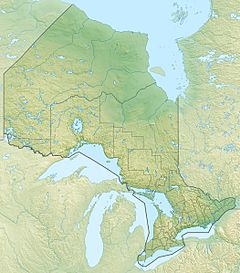Caribou River (Rainy River District) facts for kids
Quick facts for kids Caribou River |
|
|---|---|
|
Location of the mouth of the Caribou River in Ontario
|
|
| Country | Canada |
| Province | Ontario |
| Region | Northwestern Ontario |
| District | Rainy River |
| Physical characteristics | |
| Main source | Wilson Lake 447 m (1,467 ft) 49°01′17″N 91°09′56″W / 49.02139°N 91.16556°W |
| River mouth | Marmion Lake 415 m (1,362 ft) 48°56′58″N 91°16′07″W / 48.94944°N 91.26861°W |
| Basin features | |
| River system | Hudson Bay drainage basin |
The Caribou River is a cool river located in a wild, unorganized part of Rainy River District in Northwestern Ontario, Canada. It's like a watery pathway that helps carry water all the way to the huge Hudson Bay! This river starts its journey in Wilson Lake and flows into Upper Seine Bay on Marmion Lake.
Contents
The River's Journey to Hudson Bay
The Caribou River is part of something called the Hudson Bay drainage basin. Think of a drainage basin as a giant bowl where all the rain and melted snow eventually flow into one big body of water. For the Caribou River, its water eventually makes it to Hudson Bay, which is a very large bay in northeastern Canada.
How does it get there? The Caribou River flows into Marmion Lake. From there, the water continues its long trip through several other rivers. It travels along the Seine River, then the Rainy River, followed by the Winnipeg River, and finally the Nelson River. All these rivers act like a chain, carrying the water north until it reaches Hudson Bay.
Where Does the River Start?
The Caribou River begins its journey at Wilson Lake. This lake is like the "source" or starting point of the river. From there, the water flows downhill, making its way through the landscape.
Where Does the River End?
The Caribou River doesn't flow directly into the ocean. Instead, it ends its main path when it flows into Marmion Lake. This lake then connects to other rivers that continue the water's journey towards Hudson Bay.
Smaller Streams Joining the Caribou River
Rivers often have smaller streams or creeks that flow into them. These are called tributaries. The Caribou River has at least one known tributary:
- Bar Creek (which joins the Caribou River from the right side)
These smaller streams add more water to the river, helping it grow as it flows towards its destination.


